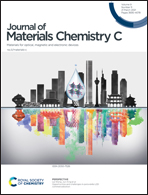Facile access to multi-state redox-active, push–pull naphthalenediimides: panchromatic radical anions and supramolecular networks†
Abstract
A facile one-pot synthetic route for the preparation of asymmetric core-modified naphthalenediimide (NDI) D–π–A scaffold(s) is reported, which consists of donor dimethylamine and arylaminoesters (1–3)/arylaminoacids (6–8) as the acceptors integrated with the NDI moiety. Importantly, dimethylformamide (DMF) has been used as a reagent to drive C–N bond formation between the donor alkylamine (–NMe2) and NDI, which is otherwise challenging to obtain similar push–pull NDIs. D–π–A systems (1–3) having aryl ester as an acceptor unit were hydrolyzed to afford another set of asymmetric D–π–A molecules (6–8) having a benzoic acid unit acceptor. Cyclic voltammetry experiments indicate multi-state redox properties with reversible oxidation and reduction potentials. Importantly, single crystal analysis of 6 and 8 reveals strong π-stacking interactions with antiparallel orientation of the molecular units. Interestingly, the –COOH groups drive infinite hydrogen bonded assembly leading to redox-active, synthon-driven supramolecular networks. Moreover, D–π–A systems 1–3 were investigated towards their ability to form radical anions. The generation of panchormatic radical anions was confirmed by the formation of characteristic Do–Dn absorption peaks covering the whole visible range and extending to the Near Infrared (NIR) region. Computational studies also reveal gradual relocation of the LUMO surface from the NDI to the phenyl esters on going from 1˙− to 2˙− and 3˙−. Furthermore, the SOMO surfaces are delocalized predominantly over the NDI units with considerable distribution over the dimethyl amine and phenyl ester substituents at the NDI-core signifying long range electronic communication between the donor and acceptor moieties in these synthesized D–π–A scaffold(s). The extension of the spin density to the carbonyl oxygen atoms can have significant ramificantions in the synthesis of open-shell supramolecular networks.



 Please wait while we load your content...
Please wait while we load your content...